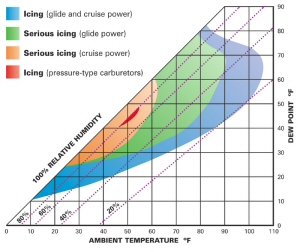Carburetor ice leads to night off-airport landing
NYC03LA012

Carburetor ice leads to night off-airport landing
While it's impossible to prepare student pilots for every problem that could conceivably arise during a solo flight, flight instructors need to ensure that their students can handle critical issues such as carburetor ice. On Oct. 24, 2002, a student pilot was seriously injured when the Piper Warrior he was flying crashed just north of Lakewood Airport (N12) in Lakewood, N.J., during a night forced landing after losing engine power.
On the day of the accident, the student and his instructor completed a 1.7-hour training flight and returned to the airport. The student then asked to perform a solo training flight; his instructor approved with the caveat that the student stay within five miles of the airport. The flight departed to the south at 6 p.m.

While descending from 3,500 feet, several miles southeast of the airport, the student applied carburetor heat. The engine began running very rough, so the student turned the carburetor heat off and the engine quit. The student then performed an off-airport landing.
After the accident, the student noted that the Warrior's engine had been running rough throughout the day. The temperature at the time of the accident was 46 degrees Fahrenheit, and the dew point was 25 degrees Fahrenheit.
The NTSB determined the cause of this accident to be the student pilot's improper use of carburetor heat, resulting in a failure to remove carburetor ice and a subsequent loss of engine power.
The student pilot might have avoided this accident had he taken advantage of the free advice in the AOPA Air Safety Institute's Aircraft Icing Safety Advisor . It says, "At the first indication of carburetor ice, apply full carburetor heat and leave it on. The engine may run rougher as the ice melts and goes through it, but it will smooth out again."
A carburetor icing probability chart shows that the temperature and dew point at the time of the accident favored carburetor icing at both glide and cruise power.
Accident reports can be found in ASF's accident database.
Posted Thursday, October 25, 2007 11:00:44 AM